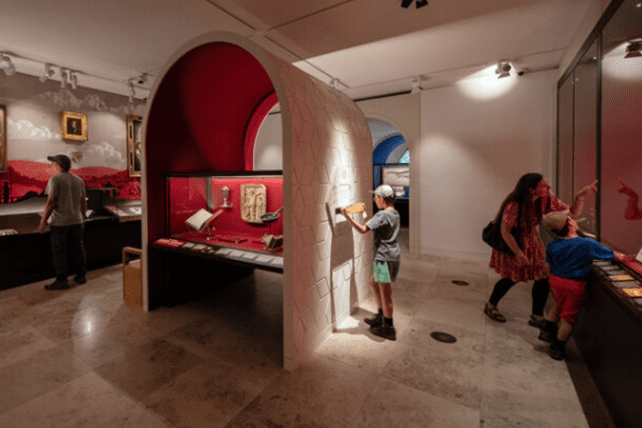BISHOP AUCKLAND, England (RNS) — The town’s name is a reminder of its history as the county seat of the bishop of Durham, one of England’s most powerful clerics. But by the end of the last century, Bishop Auckland had become a shadow of its former self, with shops on its main street boarded up, the nearby coal pits closed down and work hard to come by. But now a remarkable experiment is underway — to revive the fortunes of this northern England town through a combination of art and religion. And the final piece in its regeneration — a Faith Museum — opened its doors for the first time Saturday (Oct. 7).
Britain has plenty of medieval cathedrals and ancient monuments, but the Faith Museum is the first of its kind solely dedicated to telling the story of the country’s religious faith. And it is a dramatic story — tumultuous, often violent and always tied closely to the country’s own identity and place in the world. The museum has items highlighting the birth of Christianity under Roman rule, the power of the medieval monasteries, the polarizing effects of the Reformation, the growth of dissenting Christian traditions, the challenge of science to faith and the religious diversity of today.
The Faith Museum is the brainchild of one of Britain’s richest men, city of London investment banker Jonathan Ruffer, who was raised not far from Bishop Auckland. He has spent the last 10 years creating what he calls the Auckland Project, a series of museums, galleries, parks and other attractions.
Ruffer, who first became an active Christian at Cambridge University in the late 1960s, says the Auckland Project would never have come about if he had not undertaken an eight-day Ignatian silent retreat 10 years ago.
“It was simply supposed to be a wash and brush up, but when I was there I was mugged (by God), challenged to turn my life into one that was working with the voiceless wherever I chose. Being unimaginative, I thought it best to return to my roots here.”
Ruffer recalls that during the retreat, people staying at the Jesuit house in Wales were told at the start that a priest and a kitchen worker were ill. Each day, they were given updates on the priest but not on the kitchen worker. He was shocked.
“I found myself shaking my fist and saying to God, ‘Who’ll look after the little person?’ The answer came straight back. So that’s a dangerous question to ask,” Ruffer says.
“It was clear it was what I was called to do. The key was accepting what it was. I always define it as an Abrahamic call, in that I was clearly being sent on a journey, and, like Abraham, I wasn’t vouchsafed the destination. I really have spent years not knowing what I was doing.”
There is no sense in Bishop Auckland that Ruffer was clueless. Rather, he has responded to opportunity.
While he was looking for something to do that would make a difference, the Church Commissioners, who look after the Church of England’s money, were at the same time looking to offload a set of paintings — “Jacob and His Twelve Sons,” by the Spanish master Zurbarán. They had been purchased in 1757 by Richard Trevor, bishop of Durham, and had since been displayed in the dining room of the bishop of Durham’s castle in Bishop Auckland.
Ruffer has a particular passion for Spanish art and a substantial collection of his own, which now forms the collection in another of the town’s new museums — Bishop Auckland’s Spanish Gallery, filled with works by Spanish Old Masters, including Velazquez, El Greco and Murillo.
Although he was attracted to the idea of taking on the Zurbarán masterpieces, negotiations with the Church Commissioners were fraught. The Zurbaráns came with the castle, and they wanted £15 million. Ruffer says he never wanted to take on a building — “I don’t like them, I’m frightened of them” — and viewed the castle as a liability that needed considerable repair.

